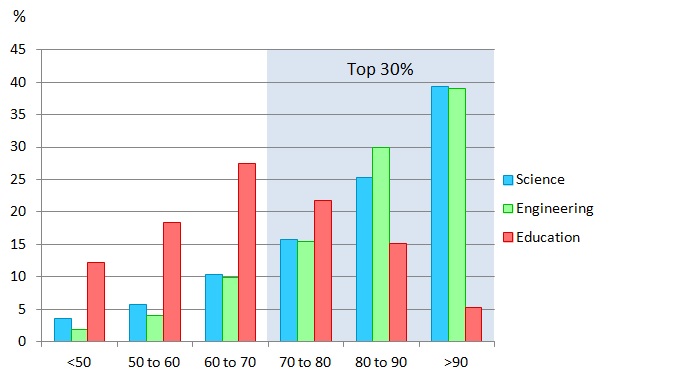Raising the professional status of teaching
In my recent Teacher article ‘Big five' challenges in school education I argue that one of the biggest challenges we face in school education is to raise the status of teaching as a career choice, to attract more able people into teaching and to develop teaching as a knowledge-based profession.
I observe that, in high-performing countries such as Singapore and Hong Kong, teachers are drawn from the top 30 per cent of school leavers. In South Korea and Finland, teachers are drawn from the top 10 per cent. In these high-performing countries, places in teacher education courses are strictly limited and competition for entry is intense.
In Australia, there appears to be an intention on the part of governments that our teachers also should be drawn from the top 30 per cent of school leavers. The Accreditation of initial teacher education programs in Australia: standards and procedures specifies that entrants to initial teacher education should have levels of personal literacy and numeracy ‘broadly equivalent to those of the top 30 per cent of the population'.
So to what extent are teachers being drawn from the top 30 per cent of school leavers in Australia?
Part of the answer can be seen in the following graph. The Australian Tertiary Admission Rank (ATAR), despite its shortcomings, is the best indicator we have of overall performance in Year 12. The graph shows that, while the vast majority of Year 12 offers to Science and Engineering courses are made to students with ATARs above 70, fewer than half of Education offers are made to students with ATARs above 70. In this country, we are falling well short of drawing our future teachers from the top 30 per cent of school leavers.

Figure 1. Percentage of Year 12 offers in each ATAR band - Science, Engineering and Education (2015)
And the picture is becoming worse, not better. Over the past three years, the percentage of Education offers made to students with ATARs above 70 declined significantly:

Figure 2. Percentage of Year 12 offers to students with ATARs above 70
A large proportion of students entering teacher education courses do not come directly from Year 12 and so are not included in these percentages. However, the ATARs of non-Year 12 entrants are unlikely to be any higher, and are very likely lower, than those of students being made offers directly from Year 12.
These observations should be of concern because the evidence is clear that the world's highest-performing nations in international achievement studies consistently attract more able people into teaching, resulting in better student outcomes. The McKinsey study of the world's best-performing school systems found that top-performing countries recruit teachers from the top third of school leavers. That study also concluded that it is not possible to make substantial long-term improvements to a school system without raising the quality of the people entering teaching. There is a clear lesson here for Australia.
A national key performance indicator (KPI)
Given that the world's top-performing school systems recruit the vast majority of their teachers from the top third of school leavers, and Australian governments appear to aspire to do the same, national progress in achieving this goal could be monitored by tracking the percentage of Education offers made to Year 12 students with ATARs greater than 70. This percentage would provide a simple national performance indicator.
This is not to say that ATAR is an ideal measure for selecting teacher education students; some applicants with relatively low ATARs can make excellent teachers. However, very high-performing countries, including Singapore and Finland, place a strong emphasis on academic achievement in their selection processes, and then also select on the basis of other attributes such as motivation for teaching, willingness to learn and communication skills. The high performance of these countries is due in part to deliberate long-term strategies to recruit future teachers from their best and brightest school leavers.
An immediate objective for Australia should be to reverse the downward trend in the percentage of Education offers being made to Year 12 students with ATARs above 70. A short-term objective should be to have most Year 12 offers (>50 per cent) going to students with ATARs above 70. A long-term objective should be to have the vast majority of Education offers (eg, 80 per cent) being made to students with ATARs above 70.
International experience suggests that the achievement of such an objective is entirely feasible. A number of countries have succeeded – usually over a period of time – in making teaching a highly regarded and sought-after career. The ability of these countries to attract more able students into teaching raised the status of teaching, which in turn resulted in still more able students choosing teaching as a career:
'Once teaching became a high-status profession, more talented people became teachers, lifting the status of the profession even higher... Where the profession has a low status, it attracts less talented applicants, pushing the status of the profession down further and, with it, the calibre of people it is able to attract.'
(McKinsey, 2007, 22)
In some of the world's highest-performing countries, entry to teaching is now as competitive as entry to courses such as engineering, science, law and medicine.
Effective policies
The construction of a performance indicator to monitor Australia's success in recruiting more able people into teaching is a first step. A second and more important step is to identify policies capable of raising the status of the teaching profession and encouraging more able people to choose teaching as a career. Here, the findings of the McKinsey study are encouraging. That study concluded that, in high-performing countries, improvements in the status of teaching were mainly policy driven; that there are common strategies and best practices for attracting strong candidates into teaching; and that the right policies can change the status of teaching in a country in a relatively short period of time.
According to the McKinsey study, effective policies adopted by these high-performing countries include:
- making teacher education programs highly selective
High-performing countries control entry to teacher education to ensure that the supply of new teachers more or less matches demand. These countries work to ensure that there is not a significant under- or over-supply of graduating teachers. This practice makes teaching more competitive and more highly valued as a career. Limiting the number of students in initial teacher education courses also can result in smaller classes and reduced pressure on professional experience placements.
- developing effective student selection processes
High-performing countries have well-developed mechanisms for selecting students for entry to initial teacher education. These mechanisms are often multi-step processes involving screening, testing and interviewing applicants. Singapore selects only one in six applicants on the basis of academic results, literacy tests and an interview that considers attitude, aptitude and personality. Finland selects only one in ten applicants using tests of literacy, numeracy, problem solving, critical thinking and information processing, and an interview that considers motivation to teach and learn, communication skills and emotional intelligence. -
paying good (but not great) starting salaries
High-performing countries pay starting compensation at or above the OECD average. An important consideration appears to be that starting salaries and the salaries of experienced teachers are in line with other professional salaries in the country concerned. -
ensuring rigorous initial and continuing professional development
High-performing countries establish rigorous initial teacher education courses and set high expectations for teachers' ongoing professional learning. In Finland, policy makers have raised the status of the teaching profession by requiring that all teachers have a master's degree.
Over the past decade, Australia has seen a decline in the performance of our 15-year-olds in the OECD's Programme for International Student Assessment (PISA). At the same time, performances in a number of other countries have improved. Lessons from the world's top-performing nations suggest that a long-term key to reversing Australia's trend will be to make teaching more attractive to the best and brightest of our school leavers, and this, in turn, will depend on a critical set of policy changes.
